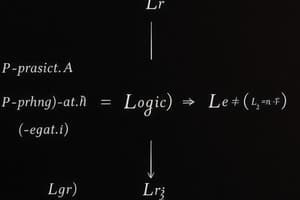Podcast
Questions and Answers
What is a proposition in propositional logic?
What is a proposition in propositional logic?
- A statement that can be either true or false. (correct)
- A type of mathematical function.
- A form of logical argument.
- An equation that always has a solution.
Which of the following connectives represents logical disjunction?
Which of the following connectives represents logical disjunction?
- AND
- OR (correct)
- IF-THEN
- NOT
When is the implication $A \rightarrow B$ false?
When is the implication $A \rightarrow B$ false?
- When $A$ is true and $B$ is false. (correct)
- When both $A$ and $B$ are false.
- When both $A$ and $B$ are true.
- When $A$ is false and $B$ is true.
What is the result of the negation of a true proposition $A$ (¬A)?
What is the result of the negation of a true proposition $A$ (¬A)?
Which connective is used to express a biconditional relationship?
Which connective is used to express a biconditional relationship?
How many connectives are generally used in propositional logic?
How many connectives are generally used in propositional logic?
What does the AND operation (A∧B) require to be true?
What does the AND operation (A∧B) require to be true?
In the context of databases, which aspect of logic is prominently used?
In the context of databases, which aspect of logic is prominently used?
What does the Halting Problem describe?
What does the Halting Problem describe?
What is a significant characteristic of Turing’s thesis?
What is a significant characteristic of Turing’s thesis?
In what aspect are Turing machines considered to be more useful?
In what aspect are Turing machines considered to be more useful?
What is one limitation imposed on arithmetic by hardware?
What is one limitation imposed on arithmetic by hardware?
What relationship does Turing machines have with pushdown automata (PDAs)?
What relationship does Turing machines have with pushdown automata (PDAs)?
What does a Turing Machine (TM) start with?
What does a Turing Machine (TM) start with?
What is the role of the head in a Turing Machine?
What is the role of the head in a Turing Machine?
In the transition function of a Turing Machine, which symbol indicates a movement to the right?
In the transition function of a Turing Machine, which symbol indicates a movement to the right?
Which of the following best describes a halting state in a Turing Machine?
Which of the following best describes a halting state in a Turing Machine?
What will be outputted by the Turing Machine when it receives the input 'aaaabb'?
What will be outputted by the Turing Machine when it receives the input 'aaaabb'?
Which part of the Turing Machine contains the rule for state transitions?
Which part of the Turing Machine contains the rule for state transitions?
What does Turing’s Thesis propose?
What does Turing’s Thesis propose?
What is the purpose of the Turing Machine's infinite tape?
What is the purpose of the Turing Machine's infinite tape?
Flashcards
Proposition
Proposition
A statement that can be either true or false, like 'The sky is blue' or '2+2=5'.
Logical Connective
Logical Connective
A symbol used to combine propositions, such as 'OR' (∨), 'AND' (∧), 'NOT' (¬), 'Implies' (→), and 'If and Only If' (⇔).
OR (∨)
OR (∨)
The 'OR' connective is true if at least one of the propositions it connects is true. For example, 'A OR B' is true if A is true, B is true, or both are true.
AND (∧)
AND (∧)
Signup and view all the flashcards
NOT (¬)
NOT (¬)
Signup and view all the flashcards
Implication (→)
Implication (→)
Signup and view all the flashcards
If and Only If (⇔)
If and Only If (⇔)
Signup and view all the flashcards
Propositional Logic
Propositional Logic
Signup and view all the flashcards
Turing Machine
Turing Machine
Signup and view all the flashcards
Halting Problem
Halting Problem
Signup and view all the flashcards
Turing's Thesis
Turing's Thesis
Signup and view all the flashcards
Limits on Arithmetic
Limits on Arithmetic
Signup and view all the flashcards
Limits on Components
Limits on Components
Signup and view all the flashcards
Turing Machine (TM)
Turing Machine (TM)
Signup and view all the flashcards
Transition Function (δ)
Transition Function (δ)
Signup and view all the flashcards
Halting State (H)
Halting State (H)
Signup and view all the flashcards
Tape Symbol (T)
Tape Symbol (T)
Signup and view all the flashcards
Start State (s0)
Start State (s0)
Signup and view all the flashcards
What is the output for the TM with input "aaaabb"?
What is the output for the TM with input "aaaabb"?
Signup and view all the flashcards
What does the TM output for an input of "aaa..." followed by an infinite number of "b"?
What does the TM output for an input of "aaa..." followed by an infinite number of "b"?
Signup and view all the flashcards
Study Notes
Course Information
- Course: M269
- Topic: Algorithms, Data Structures and Computability
Agenda
- Prepositional Logic and Predicate Logic
- Turing Machine
- Computability and Limits of Computation
Logic in Computer Science
- Propositional logic is fundamental to computers and circuitry.
- Databases use query languages.
- Programming languages, like Prolog, use logic.
- Design validation and verification utilize logic.
- Artificial intelligence (AI) systems, such as inference systems, use logic.
- Propositional Logic
- First Order Logic
- Higher Order Logic
- Temporal Logic
Propositional Logic: Syntax
- A proposition is a statement that's either true or false.
- Propositional symbols (e.g., A, B, C) represent propositions.
- Connectives (e.g., OR, AND, NOT, implication, if-and-only-if) combine propositions.
Propositional Logic: Semantics
- Truth tables define the truth values of compound propositions.
- OR (∨): True if at least one proposition is true.
- AND (∧): True if both propositions are true.
- NOT (¬): True if the proposition is false, and vice versa.
- Implication (→): False only if the first proposition is true and the second is false.
- If-and-only-if (↔): True if both propositions have the same truth value, false otherwise
Tautologies, Contradictions, and Contingencies
- Tautology: A proposition that is always true, regardless of input values.
- Contradiction: A proposition that is always false.
- Contingency: A proposition that can be either true or false, depending on the input values.
Propositional Equivalences
- Two statements are logically equivalent if their truth tables are identical.
- Examples of equivalences were shown demonstrating equality through truth tables.
Inverse, Converse, and Contrapositive
- Implication (if-then) statements have hypothesis (p) and conclusion (q).
- Inverse: ¬p → ¬q
- Converse: q → p
- Contrapositive: ¬q → ¬p
Predicate Logic
- Predicates are expressions of one or more variables.
- Quantifiers (universal and existential) quantify variables in predicates.
Quantifiers
- Universal quantifier (∀): A statement is true for all values of a variable.
- Existential quantifier (∃): A statement is true for at least one value of a variable.
Nested Quantifiers
- Quantifiers can be nested within each other to create more complex statements.
Rules of Inference
- Rules of inference provide templates and guidelines for constructing valid arguments in logic.
- Examples of rules of inference include addition, simplification, conjunction, modus ponens, modus tollens, hypothetical syllogism, destructive dilemma, and disjunctive syllogism.
Turing Machines
- Turing machines model computation.
- They consist of an infinite tape, a head, and a set of states.
- A Turing machine takes input, manipulates symbols on the tape, and either halts or runs infinitely.
Turing's Thesis
- All effective procedures (algorithms) can be simulated by a Turing machine.
- Modern computers are essentially simple Turing machines.
Halting Problem
- The halting problem is the problem of determining whether a program will halt (stop) for a given input.
- The halting problem is unsolvable i.e., no algorithm can solve it.
Computability and Limits of Computation
- Discusses limitations in arithmetic, hardware components, communication, and software.
Limits
- Arithmetic: limitations in representing numbers;
- Components: hardware malfunctions,
- Communication: error-detecting/correcting codes,
- Software: software bugs present in commercial software, although testing helps.
Studying That Suits You
Use AI to generate personalized quizzes and flashcards to suit your learning preferences.




